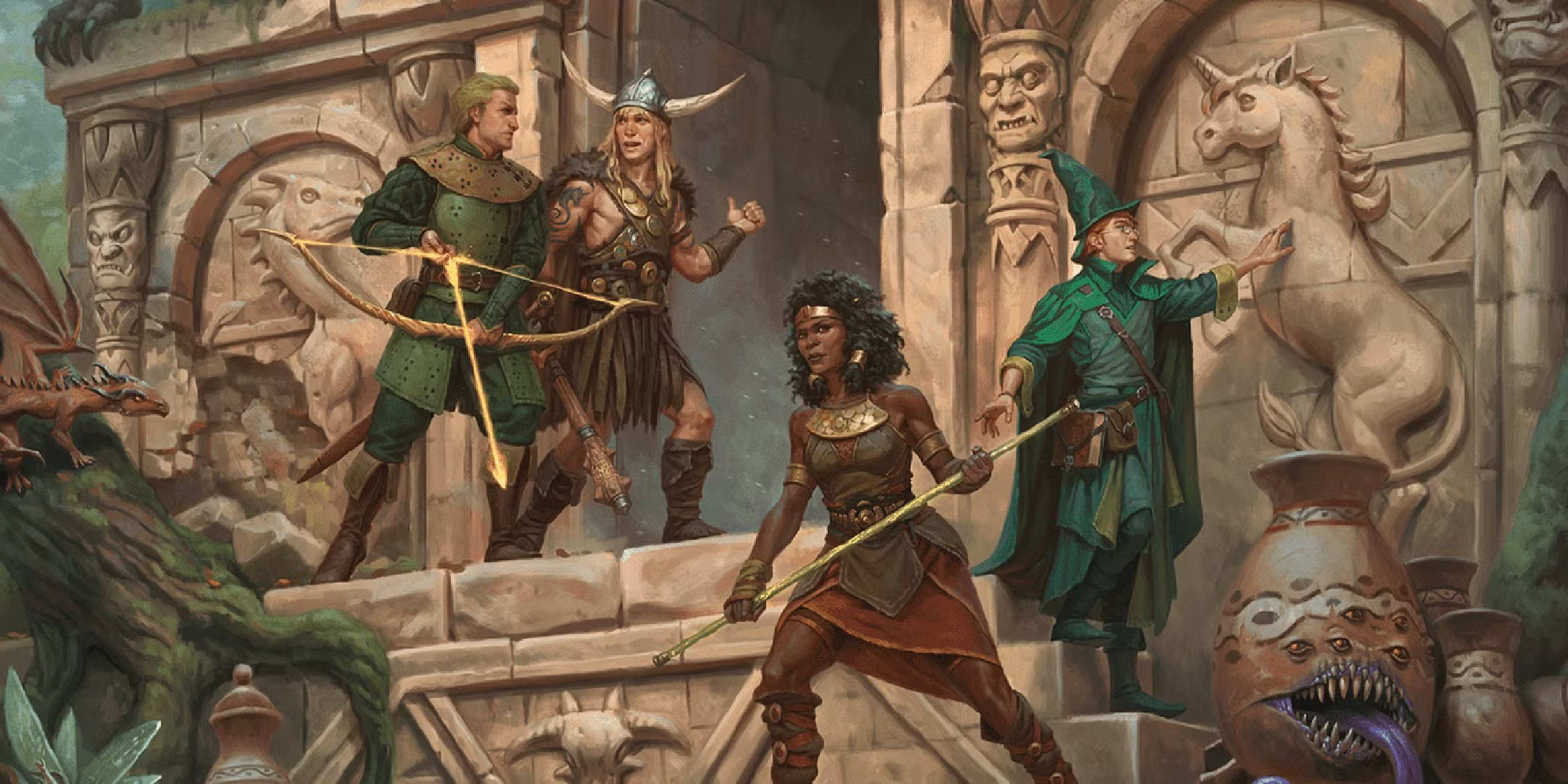
We get it, when in the wilderness and you’re traveling to your destination, sometimes it is easier to do a survival check and move on. But you should be roleplaying these aspects. Talking and telling about how actions are done, even while traveling, is part of the experience. After all, it’s not the destination, it’s the journey.
While it could be sitting around a campfire, scavenging for food, or building shelter, it is part of getting to bond with your party. Yes, not every situation will need detailed specific explanations. But it will show off your skills if you have some tricks up your sleeve.
What survival tips could help you in your DND game?
Halt!
Take A Moment and Support Knight’s Digest!
Adventurers, if you’ve enjoyed the content we’ve worked so hard to create, we humbly ask for your support. Running Knight’s Digest takes countless hours of dedication, creativity, and passion, and we’d love your help to keep our dungeon full of treasure (and coffee).
If you think we’ve earned it, consider donating to help us continue crafting the stories, resources, and ideas you love.
Make a one-time donation
Make a monthly donation
Make a yearly donation
Choose an amount
Or enter a custom amount
Your contribution is appreciated.
Your contribution is appreciated.
Your contribution is appreciated.
DonateDonate monthlyDonate yearlyWhat Exactly is A “Survival Check”?
Survival Checks, based on your wisdom, have a few different uses. The Dungeon and Dragons 5e rules state it’s to “check to follow tracks, hunt wild game, guide your group through frozen wastelands, identify signs that owlbears live nearby, predict the weather, or avoid quicksand and other natural hazards”.
As you can tell, they just give specific examples to play off of. Those who have a higher wisdom will of course have better survival skills.
There will be a few different categories we will base this on. Tracking, foraging, navigation, and shelter building will be the main options you as a player will want to consider while traveling.
Tracking in Dungeons and Dragons
Tracks
Tracking animals or other creatures will be pivotal to your survival check. There are a few key features of tracking creatures that will help guide you toward them. One of the first signs is the actual tracks themselves.
It is important to know what you are tracking, recognizing what prints are being left behind by what creature is the first “step”. It could be human tracks, but if you do not know the difference between peasant tracks to soldier tracks, your party might be in for a surprise.
What clothes might a peasant be wearing? Check out How to Play a Peasant: Ye Old Roleplaying Guide.
Droppings
While human waste might be familiar to the human eye, looking for other creatures might be a whole other array. Scat, or droppings as it is known, is another pivotal sign of wildlife in nature. If you are looking for a monster that is known for eating local villagers, you most likely will not find a high intake of vegetation in their droppings.
On the other hand, if it is a carnivore, there will be bone fragments and possibly fur. Overall droppings let you know there is a living creature near you. Whether it is looking for game to eat, or that man-eating monster mentioned before, if you see poop just know something is close by.
Feeding Signs
As mentioned in droppings, what you find in their stool can determine what you’re tracking. Just as we have to eat, most other evil beings in Dungeons and Dragons have to as well.
If you are looking for a herbivore-type creature, there are numerous hints to look for. Trees that have their bark stripped are a sign. Carnivores will leave behind remnants of their meal such as feathers and bones.
This is a great time to look for a water source nearby. Just like food, water is a very important substance. This is not just for animals, if tracking a group they will also need to stop for good clean water. Along the water it will be muddy, so be on the lookout for tracks in the mud, or moved gravel.
Other Tracking Techniques
I will quickly go over the last couple of details you should look out for. Small things like hair being caught as they traverse or signs of shelter are important. Animals or beings with flight will build nests or possibly take shelter in trees while most mammals might burrow.
Some other important features that any player should be ready for can be numerous. It really depends on the species, and that is why homebrew or just straight improv is so much fun in DND.
Foraging For Food

While foraging for food will obviously be different in the Dungeons and Dragons universe compared to our real world, the same tips can be applied.
There are a few main ideas for foraging. I would say the number one tip for gathering food is to be cautious. Unless you are 100% certain that the food you will be eating will be safe, don’t eat it, even with decent survival checks. A 19 is not a 20, all it takes is one mistake for you to be poisoned and possibly make your party wait several days or use valuable spell slots/potions to have you recovered.
From there, harvest responsibly and at all costs know your poisons. Be knowledgeable of the species of plants that are not edible vs those that are. An example of edible resources that most likely will be found in the wilderness of your campaign could be watercress, dandelions, wild strawberries, and mint.
We would recommend that the higher the survival check, the more resources your players would be able to find.
Navigation
Let’s face it, someone in the party always assumes someone else brought a pivotal item. If you are completely lost and your DM is feeling like they want to torture you a little, don’t worry, we have got you covered.
While having a map is the best option, there are multiple ways to get your bearings together. In general, you will still need to know where you are going. If you know what direction you are heading or came from, then that should be the bare minimum amount of knowledge to get to where you’re going.
Using the Sun
The cosmos can give many hints in terms of navigation. The main focus of this category would be making your way through terrain during the day. Depending on the time of year, the sun will be up longer and will give you a more ample time to make use of it.
This is a classic survival tip, and unless your universe follows other rules, we will assume that the sun will travel from east to west. You will need to find a stick (or maybe an unmovable rod) that measures about three feet. Placing it vertically in the ground, mark the tip of the shadow. After about 10-15 minutes have passed, mark the tip of the shadow once again.
You now have your east and west directions marked (the sun rises in the east and sets in the west). From there you should easily be able to pinpoint north and south on your compass.
Navigating at Night
Survival checks at night might be considered to be a disadvantage and might be rolled as so. It makes sense, it’s dark. Unless you have vision to see into the darkness or a tool that helps, then you could quickly get turned around. So what survival tips could help your survival checks?
While we have the North Star, which is connected to the Big Dipper, it may be different in your story. I would implore you to do some research on this and as a DM possibly introduce this to your universe. While the players could walk blindly around at a disadvantage, we believe there should be some sort of solution to the problem.
Building Shelter in Dungeons and Dragons 5e
There are multiple spells in Dungeons and Dragons that can help players survive in the wilderness, especially when it comes to building shelter. For example, Mold Earth could be deemed effective or even better, Tiny Hut.
What if you just got done with battle and do not have any available spell slots? Don’t worry there are a few survival tips to help survive the night.
Location is one factor, finding a place that is not only safe but that will have access to supplies you will need is pivotal. Once located this is the time to realize size does not matter (even though sometimes it does, check out DM Advice: Does Size Really Matter In Dungeons and Dragons?).
Building something too big can be seen very easily and if anything heavy were to fall on you (like a heavy stick), it could knock down that valuable HP. Make it small, possibly just big enough for yourself. Use surrounding Leaves and sticks to create your own version of the Tiny Hut spell. Make sure there is insulation and a heat source. Depending on the time of year it might be yourself or a small fire that keeps you warm.
Survival Check in DND
Overall, we want to add flavor to the story. If you are playing a Ranger, then of course you would know some of these tips. Sometimes DM’s want a description of how you are doing your task, which is supposed to bring your character to life.
Hopefully, with this new knowledge, you will not only be impressing your fellow adventurers but surviving the wilderness!


Total Party Kill Productions
Delve into the Dungeon
Step into the world of adventure with these Dungeon Delver Club shirts—the depths are calling, answer the call!










Leave a Reply